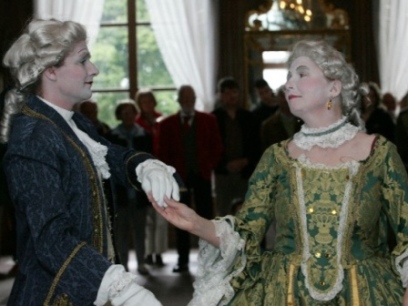Dances are (were) always and everywhere a bottom- up culture. The people danced to celebrate, mourn, or wonder whether to react to life, such as dancing around the maypole or the torch dance at St. John’s day. Often the secular or religious government is trying to curb or prohibit the licentious behavior. After which the nobility picked it up themselves and imitated, and polished it with courtly and refined mannerisms and elevated it to art.
 Dance at funerals or in the cemetery was in early Christianity normal, but already in the fifth century Augustine in a sermon disapproved this. He found that the church in which the relics of St. Cyprian were ".... was disrupted by the sickening insolence of dancers."
Dance at funerals or in the cemetery was in early Christianity normal, but already in the fifth century Augustine in a sermon disapproved this. He found that the church in which the relics of St. Cyprian were ".... was disrupted by the sickening insolence of dancers."
In 743 were sinful dances by the Concilium Germanicum banned because of their (alleged) pagan ritual origin. In 745 were all religious dances by Pope Zacharias simply prohibited. Later, the church tried to Christianize it, by allowing them to be danced in a more subdued form for processions.
In the 15th century folk dances in Europe were adopted and refined by the dance masters for the aristocracy in France and Italy. The possibilities were dependent on the current mode and space. The ladies wore long drag and gentlemen tights and shoes with very long points. This limits the possibilities of course.
The Estampie is considered to be the first court dance.
A court ball was subject to strict rules and codes of conduct, with assigned places to sit and dance. In order of rank the couples lined up, bent towards each other and danced the Branle with stately dance steps. The 'reverance', the bending was a part of every dance at the court.
Then came the Gavotte, and early 16th century, the Galliard. Which included large and exuberant leg movements and leaps.
Then came between 1650 and 1750, the period of the Minuet with measured small formal steps.
The 18th century was the period of the waltz with sliding steps and a lot of running. In between there were many other popular dances, such as the courteous Pavane, a walking dance, and the stately Sarabande.
All courts had dance masters employed. The first one that is now known, was Domenico Piacenza. In 1614 he published "De arte et saltandi choreas ducendi ', the first dance that as a book manuscript is preserved. Dance Master described steps and dances with a notation system, teach them and lead the ball in the right direction.
At parties to the court was between the dinner parties also dancing. These dances are called Intermediëen or Intermezzi.
From the court dance arose the classical ballet. King Louis XIV, the Sun King, (France) danced the lead in ballet performances. He founded the first ballet academy and an academy of music that are still in Paris.
Among others in the films Pride and Prejudice, and Casanova are examples of dances to see that were made to the court as An der Blue Danube, Anne polka, quadrille, the Contredanse, the Allemande and the Mazurka.
There are very few organizations that are involved in court dances, especially with the yet almost unknown 18th (rococo) and 19th centuries (Biedermeier).
Their traditional rococo costumes consist of a robe and below for the ladies paniers (baskets) to show a substantial hip party. The men wear shorts with white socks, a vest and a long coat thereon. Both wear a wig and traditional makeup: a white powdered face with red cheeks and lips.
The Biedermeier costumes for the ladies have a hoop skirt adorned with a long dress over it. The hair is pinned up and occupied with flowers. The men wear a costume, and have a fairly militaristic attitude.
The Rococo is danced gracefully, the Biedermeier tight.
